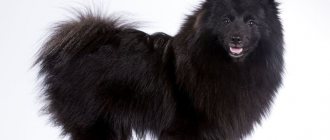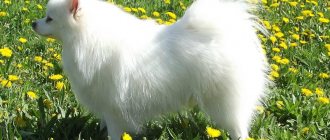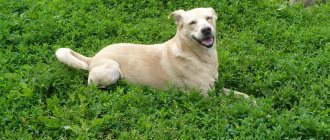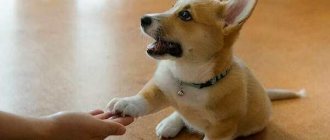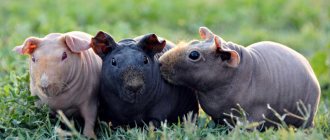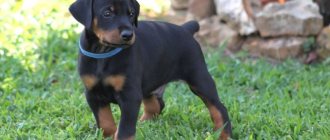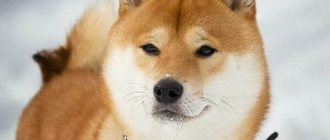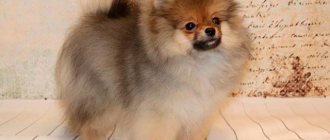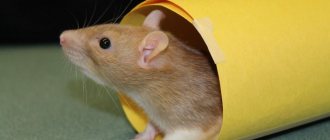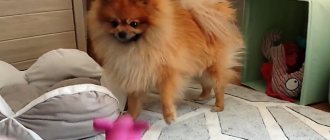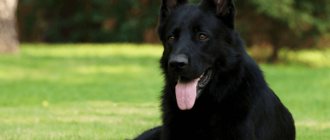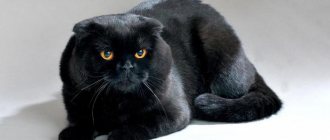This is the name given to all the varieties of dogs that the Spitz breed includes because they have many common features. These include: protruding thick fur, a tail curled up, pointed ears, a charming “smiling” face with shiny beady eyes.
The breed is extremely popular due to the miniature size of the dogs and their toy appearance. The most common types of pets are dwarf and Pomeranian. In some countries they are considered an independent variety, and in some they are classified as a dwarf breed of German Spitz.
Description of the Pomeranian Spitz breed
Popularity 2nd among 263 dog breeds
Lifespan:
14-16 years old
Breed group:
Decorative
Height:
18-22 cm
Country of origin:
Germany
Average price:
30-50 thousand rubles
Weight:
1.4-3.2 kg
Latest articles Cat health
Ataxia in cats: what is it, how does it manifest and is treated 01/23/2022 163 0 0
Cat health
Leukemia, or viral leukemia in cats 01/23/2022 148 0 0
Breed traits
Breed traits (on a 5-point scale)
| Pomeranian Spitz | |||
| Activity | in the house | 3.4 | |
| on the street | 3.4 | ||
| Obedience | training | 3.6 | |
| strangers | 3.6 | ||
| Domination | in family | 1.4 | |
| over dogs | 2.5 | ||
| Defending your territory | from people | 2 | |
| from dogs | 2.8 | ||
| Sociability | in family | 4.6 | |
| with strangers | 3.9 | ||
| with dogs | 3.6 | ||
| Concentration | in family | 1.6 | |
| in front of strangers | 1.9 | ||
| with dogs | 1.9 | ||
| Aggressiveness | in family | 1.5 | |
| to strangers | 1.8 | ||
| to the dogs | 2.1 | ||
| to cats | 2.3 | ||
| Family behavior | calmness | 4.2 | |
| demand for affection | 4.3 | ||
| excitability | 4.1 | ||
| playfulness | 4.1 | ||
| excessive barking | 3.5 | ||
| behavioral breakdowns | 1.9 | ||
| Tolerance for children | up to 4 years | 3.1 | |
| over 4 years old | 3.8 | ||
| Institutional use | watchman | 4.3 | |
| bodyguard | 1.7 | ||
This breed is often compared to the following dog breeds: Chihuahua, Pug, Maltese (Maltese Bichon), Papillon, Bichon Frize.
Pomeranian Spitz
Pomeranian Spitz
Key facts
As much as this fluffy bun, which looks like a soft toy, is unkind to mischievous children, it is so faithful and loving towards its owner.
A chain and a calm, measured life are not about the Pomeranian. Active style and long parties - this is the element and the main characteristic of the Pomeranian Spitz breed. The dog remains active until old age - he runs, swims and tumbles in the snow.
It has not been scientifically proven, but there is an assumption that Pomeranians treat depression. The Pomeranian adopts the traits of its beloved owner and, like a chameleon, adapts to the character and rhythm of the owner’s life.
The world famous composer Mozart raised a Pomeranian named Bimperl. The famous Austrian was so imbued with feelings for his pet that he wrote a short sonata for the dog. In addition to Mozart, Martin Luther and Sylvester Stallone kept a Spitz, and in Chekhov’s story “The Lady with a Dog” the main character walks with a Pomeranian Spitz according to the author’s idea. A Pomeranian dog appeared in The X-Files.
Regardless of the conditions in which the pet lives - in a spacious house or a small apartment - you need to walk the dog at least twice a day. Choose a spacious area to keep your Pomeranian in good shape. The description of the Pomeranian Spitz breed speaks of the need for high physical activity of the dog.
Spitz dogs come in the following colors: orange, sable, chocolate, blue, black, white. The baby's muzzle is half the size of the skull and is flattened.
The life expectancy of the Pomeranian Spitz is reaching a record. Dogs easily cross the threshold of 15-16 years, and some individuals live up to 20 years.
Pomeranian puppies
It is best to pick up babies at 3 months. It is at this age that the first molt occurs, and then the teeth change. Also during this period, they are just beginning to explore the world around them and perceive changes more easily, and also gain skills with which they will have to live in their future lives.
Puppies
Conventionally, a puppy’s maturation can be divided into phases:
- Socialization (8-12 weeks) is an important stage of growing up. It is during this period that the relationship between the dog and the owner, as well as other family members, is formed.
- Determination of social roles (13-16 weeks) - at this age the puppy tries to take a dominant position and become a leader in the house. Give your pet more attention and teach him obedience by showing him who's boss, but without scolding the puppy.
- Establishment of hierarchy (5-6 months) - the desire to dominate increases, which requires greater firmness and attention on the part of the owner to the pet.
- Puberty (7-9 months) - males begin to mark their territory, and females go into their first heat. They are not adults yet, but they are no longer children. Spitz dogs cannot be bred during this period. It is optimal to do this at one and a half years.
Features of boys and girls
Bitches are much kinder than males. Girls are affectionate and loving, and boys are handsome and cocky.
Without a doubt, males look more impressive. They are distinguished by their wayward character and stubbornness, unlike girls.
Dwarf Spitz
Bitches are considered more docile and soft; there are no problems with the tray, because they do not need to mark their territory. They learn new material more easily and are amenable to training.
History of the origin of the Pomeranian Spitz
The Pomeranian didn't always look like a little fluffy ball. Now it is difficult to imagine that the ancestors of the Pomeranian - turf dogs - were used for movement and protection due to their endurance. In Iceland and Lapland, turf dogs are still in use. Later, the breed earned the respect of the nobility, and society ladies considered it an honor to appear at a social event with such a handsome friend.
Spitz dogs began to look miniature thanks to the Germans - the inhabitants of Germany bred Spitzhunds, which are the closest in appearance to Pomeranians. Researchers are still arguing who should be given credit for the breed: German Württemberg or Prussian Pomerania. In the end, we settled on the last option.
Queen Victoria of England became interested in the little beauty, and experts were racking their brains on how to turn a 15-kilogram animal into a smaller one, weighing three kilograms. In 1892, the plan was realized, and 11 years later the first exhibition of Pomeranians took place.
American dog breeders continued to work on reducing the breed and came across a problem - the small size of the dogs negatively affected the duration of the breed. Scientists have concluded that coat color affects size - white individuals grew the largest, but blue coat color was difficult to maintain.
The breed was given a laconic name - Pomeranian, but the International Canine Organization calls Pomeranians “German Spitz”.
Kinds
Pomeranians are classified according to the main branches in the breed, coat color and size. Subspecies include:
- Japanese;
- Italian volpino;
- American Eskimo;
- German Wolfspitz;
- miniature Pomeranians;
- large individuals.
According to the color of their fluffy fur, Pomeranians are:
- bright red;
- redheads;
- black;
- white;
- brown;
- blue;
- cream;
- sable
According to the size of the spitzes, they are distinguished as:
- small or dwarf, which grows up to 29 cm;
- medium, height from 30 to 39 cm, which weighs up to 11 kg;
- large, growing up to 50 cm, and weighing up to 20 kg.
To determine the size and weight of a dog in the future, you can use a growth chart, taking into account its current age and weight, and calculate a further forecast according to its size. The table can be found on the Internet.
Appearance of a Pomeranian Spitz
General impression
The dog belongs to the dwarf breed. Contrary to this fact, the Spitz has muscles and a dense body. The height of the Pomeranian Spitz is equal to the length of its body - no more than 22 cm.
To participate in the exhibition, the weight of the pet must not exceed 2 kg. True, the dog shouldn’t weigh less either.
Owners lovingly compare the puppies to a mix between a fox and a bear cub. Looking at the photo of the Pomeranian Spitz, it is easy to draw an analogy with the mentioned animals.
Head
The head of the Spitz is small, wedge-shaped. Chubby cheeks hide existing cheekbones. The muzzle is half the size of the skull, the nose is black or brown. It's the same with lips. The triangular, pointed ears stand upright, but puppies are born with floppy ears. The beady eyes are slanted, oval shaped with dark lids. The Pomeranian is also called a fox cub because of its mischievous look.
Spitz dogs have 42 teeth and the upper jaw overlaps the lower jaw.
Neck
There is a lush frill on the neck. If you look at the neck from the side, you will notice a convexity. It is medium in length.
Frame
The Pomeranian's ribs can be easily felt, the belly is tucked, and the withers begin where the neck ends.
Forelegs
The legs stand wide, the shoulders are muscular, and the paws are like those of a cat. The pads are dark in color and the claws are pigmented black.
Hind limbs
The legs are parallel to each other. The paws are not as round as the front ones.
Tail
The shape of the middle tail resembles a twisted ring. The tail is set high, and part of it lies on the back.
Movement
The Spitz is light and flexible when running. It pushes off with its hind legs and springs.
Wool
Double fur. The hair on the head is short, as well as on the ears and paws. The hair on the body is longer. The fluffy, rich tail imperceptibly blends into the “pants.”
Color
According to the approved rules, there are nine colors of the Pomeranian Spitz - white, red, blue, cream, black, blue, sable, chocolate and multi-colored.
It’s up to you to choose what color you want to buy, but please note when purchasing that clear white spots on the fur are considered a defect.
Size
When standing, a boy Spitz reaches 22 cm at the withers, a girl – 18 cm. The weight of a Pomeranian Spitz does not exceed 3.2 kg. A too thick physique indicates impending obesity. The size of the Pomeranian is ideal for those who want to have a four-legged friend in the apartment.
Peculiar habits and habits
Spitz are very inventive creatures. They can learn funny tricks even without training, once they understand what their owner might like. Many of them can walk and stand on their hind legs. Others “clap their hands”, etc.
These dogs often have a love for water and bathing. They are generally for an active lifestyle. They love to dive into the snow or roll in dry leaves.
They love to travel. As a rule, they tolerate car trips well. They are comfortable with carriers and special backpacks. Just to be close to the owner.
Character of the Pomeranian Spitz
The dogs' tiny size is compensated by their big hearts and unstoppable enthusiasm. The animal will not quietly lie in your pocket and wait for you to pay attention to it. The Spitz enjoys gambling and walks in the fresh air. Combine both points. Even a trained Pomeranian does not hesitate to run after birds and toys; in addition, he will rush to help in the event of an attack.
Natural tact will not allow a well-mannered Spitz to wake you up early in the morning - the dog will wait until you get some sleep, and sometimes lie around with you. After work, the little bear will greet its owner with hugs. The animal will respond to a suspicious rustle with a loud bark - pay special attention to this aspect in raising your pet.
If you teach your pet to communicate with children from childhood, then in the future the adult dog will grow up to be a reliable companion. The Spitz will react unkindly to strangers holding out their hand on the street to stroke its shiny fur, and it is not a fact that it will allow this.
At home he gets along with other animals, but likes to dominate. He is wary of rats, birds and hamsters - he may become interested in them and mistake them for lunch.
If you got a puppy, then let his energy escape, otherwise life in the apartment will turn into hell - the attributes of furniture and decor will be used.
It is convenient to take the dog on trips - the Spitz will be happy about this, and the breed’s acclimatization goes smoothly. In general terms, the character of the Pomeranian Spitz not only touches, but also makes you admire the small but proud dog.
Advantages and disadvantages of the breed
Spitz have pros and cons of the breed, being no exception. Its advantages include:
- The animal eats little and is unpretentious to food.
- Does not freeze in severe frosts.
- The cheerful and energetic disposition of the Spitz goes well with the active lifestyle of the owner.
- Gets along easily with household members and other pets.
- Doesn't let you get bored.
- It is everyone's pet.
The breed has serious disadvantages. These include:
- As a result of selection, a small Spitz (like a bear cub), whose muzzle is made shorter and shorter by breeders, acquires respiratory pathology due to deformation of the trachea and nasopharynx.
- The excitement of the game can ruin things.
- An incredibly loud animal.
On a note! The dog is extremely sociable, so it is difficult to tolerate long separation from household members. It is undesirable to leave him at home alone for a long time, as he begins to feel sad.
Education and training
The Pomeranian is one of the most intelligent dogs among toy breeds in the world. Only his stubborn nature will hinder his training. Conventional methods of raising and training a Pomeranian will not work - study your pet and find an individual approach.
Do not pay attention to the funny, touching appearance - the pet is capable of serious exercise and work, despite its appearance and size. There will be no problems in training if the Spitz feels that you are a strong owner. Once inspired, your four-legged friend will delight you with tricks worthy of circus performances. But if for a moment he turns out to be stronger than you, then do not expect obedience.
The fluffy bun appreciates delicacy and praise. He does not accept cruelty and criticism, and will react to disrespect with aggression and arrogant behavior.
Trainers warn that the question “how to toilet train?” may be a problem. Incontinence in Spitz dogs is related to physiology - the bladder does not store contents for a long time.
At three months, teach your puppy etiquette around strangers. There are no ideas on how to wean a student from asking from the table - ignore the plaintive hungry look. Otherwise, don't expect respect. Is it possible to be tough and tyrant? No, either, keep the golden mean
Bring reward food for your pet on a walk. The puppy should walk with you for half of the walking time, not pick up anything from the ground and not approach strangers.
Looking for a Pomeranian? Find your pet from 6 offers Buy as a gift
Owner reviews
Based on reviews from owners, we can safely and immediately say that Pomeranians never get along with passive and lazy owners. This breed requires constant attention and constant activity, which is very important for the health of the pet. It has been noticed that Spitz feel great in any company, both in the company of children and in the company of older people who prefer an active lifestyle.
When choosing a friend and companion in the form of a Pomeranian Spitz, you should pay attention to the characteristics of the breed of this dog. This animal's fur stands vertically, which gives the animal originality and attractiveness. You should also pay attention to the fact that this dog barks loudly, which is annoying for the owner and family members. But this fact will “come out” only when the animal is not raised and trained.
You should also pay attention to such a fact as the stubbornness of the breed. Therefore, without the stubbornness and perseverance of the owner of this pet in matters of training and education, it may happen that the Pomeranian will ignore the execution of various commands and try to take over, demonstrating his character.
In their own eyes, every Pomeranian sees themselves as a huge and fearless animal, despite the fact that they are distinguished by their miniature dimensions. These dogs may attack other dogs that are much larger and much older. It is not for nothing that in ancient times, owners used the ancestors of these dogs to protect their homes.
Pomeranian Spitz Health and Diseases
Compared to other dwarf breeds, the Spitz is full of strength and bearish health.
Mats may form on the fur or, conversely, dogs are susceptible to baldness in certain areas and black skin disease, when the hair falls out and the skin becomes pigmented. This disease does not negatively affect the internal organs.
Possible diseases
Marbled Pomeranians are sometimes born deaf, with high eye pressure and irregular eye lining.
Diseases characteristic of Spitz:
- weak ligaments;
- dislocation of the knee joint;
- gastritis;
- cough;
- atrophied retina;
Tumors are rare.
It is important to monitor the food and your pet’s reaction to it to see if there is an allergy. Poor nutrition can cause hair loss and obesity.
If your tailed friend is inactive and lethargic, whines, suffers from shortness of breath, limps, refuses to eat, and his face is sad, it’s time to find a smart veterinarian and call him to your home.
Reproductive health
It is better for girls to prepare for childbirth at the age of no earlier than two years, and do not worry that estrus will begin as early as six months - the breed is miniature, so early pregnancy threatens complications. The boy is ready to continue the birth after six months, but the period after a year is considered a favorable time.
Dogs must be healthy, without epilepsy, diabetes - otherwise the fertilization process is prohibited. A month before day X, vaccinate the newlyweds and treat them against parasites.
Mate your pets in the morning, before the exciting process, leave the animals hungry and make sure that they satisfy their physiological needs. Mating takes place at the boy's home and is controlled by the owners.
If you feel unsure, invite a knitting instructor. Remove unnecessary spectators from the room. Let the future parents meet and muzzle the female. During the process, make sure that the female does not twitch and damage the male’s organ. Dogs must remain in the “castle” for 15 minutes.
After an exciting event, you need a good walk. For greater persuasiveness and support for future offspring, repeat the mating after two days - the dogs will feel more confident the second time.
Sterilization should be carried out two weeks before estrus or two months after it.
Mating and birth
Spitz - males reach puberty before 9 months. Females - by 9 months, as they begin their first estrus. Which does not mean she is ready for mating. Pregnancy and childbirth in females are difficult, especially in small breeds. The reasons for the difficulties are:
- Miniature size of the breed.
- It is better to start mating for males at 12 months, and for females at 15 months.
- By this time, females have established a regular cycle.
- Animals must be adults (reaching puberty), full-fledged, healthy.
- For mating, it is necessary to create normal conditions (a favorable atmosphere, absence of stress for the animals), since this can negatively affect further pregnancy, childbirth, and offspring.
In cases of negative conditions, mating may not take place. A veterinarian should monitor the process of pregnancy and childbirth of a dog.
Important! Animals need to be prepared for mating. The male and female should not be sick. Animals should not be mated after recent exhaustion in the absence of adequate nutrition, vitamins, minerals, or if the individuals are extremely overfed.
Features of feeding and diet
Be patient and do not feed your Spitz from the table, no matter how much you want to. Sweets, flour, smoked foods, milk, river fish, fatty and spicy foods are prohibited in the diet. Use turkey, beef, grains and vegetables, one egg per week.
What food to give and how to feed is up to you. According to the observations of the owners, dry food, even if it is super-premium, will cost less than natural food. Look at the condition of the dog, what to feed, how many times to feed and whether it is possible to give the pet certain foods.
Puppy Feeding Guide
Find out how the puppy ate in the kennel and feed him the same food so that he acclimatizes. After two weeks, introduce your rules.
At 3-4 months, feed 4 times a day. Don't give dry treats or bones - your puppy will choke or get hurt. Chew on a raw beef knee joint. Before doing this, leave the knee in the freezer for three days.
Adult Feeding Guide
After four months, the Spitz eats three times a day. According to this routine, the animal lives for up to a year. Afterwards, limit your diet and leave two meals.
How much to feed - the norms are calculated not by age, but by body weight - 30 grams of meat per day per kilogram of the pet’s weight.
Remove food that your pet has not eaten within 15 minutes. Have meals at the same time every day. The pet's dining room should be clean and ventilated, and the water should be clean.
Nutrition
A properly formulated diet for a Pomeranian is an important part of caring for your pet. If the food is of poor quality and unbalanced, this will affect its activity and coat. The coat will lose its shine, constant shedding will begin, and the dog will feel tired.
Expert opinion
Anna Abramenko
An avid dog lover. Experience in veterinary medicine since 2009.
Ask a Question
From puppyhood, the dog should be accustomed to regular foods, with dry food as a supplement. If a dog is accustomed to this diet from childhood, it will begin to refuse normal food.
When bringing a puppy from another owner, where he spent the first months of his life, you should also obtain information about what the dog was fed. It takes time to switch from one diet to another, from 7 to 10 days. You need to change products gradually.
The orange diet should contain:
- raw and cooked meat;
- dairy products;
- cottage cheese;
- stewed vegetables with vegetable oil;
- eggs;
- dried fruits.
It is necessary to monitor the weight of a small dog, since breeds with short legs will have difficulty moving when their body weight begins to exceed the norm. Fat dogs become lazy and lose activity.
Foods that are unhealthy for a Spitz and cause problems with weight and health are the following:
- whole milk;
- fatty pork;
- fried and smoked foods;
- sweet products;
- sausage;
- salty food;
- cold and hot dishes.
Useful article: What to feed your Spitz: 10 best premium dry food for Pomeranian and German Spitz
Care and maintenance
Half of the problems will disappear if the pet adheres to proper nutrition. The second half of the problem lies in the thick coat. Pomeranians shed twice a year. Females also lose their fur during estrus and after giving birth. So if you want your Pomeranian to look neat in general photos, take care of the coat first.
A long-haired breed should not be allowed to breed. Make it a habit to brush every four days, or daily when shedding. Brush outside and against the grain - this is also a good massage. Bald spots are a sign that you are using the wrong shampoo or food.
If you are lazy and don’t comb, your home will not only become dirty with fur, which is not so bad - your pet will develop dermatitis or parasites will appear on the skin. Therefore, the care and maintenance of a Pomeranian Spitz requires a lot of time and effort.
Carry out washing twice a month and, in addition to shampoo, purchase conditioner for soft wool. To prevent the coat from growing shapeless, use thinning scissors to cut hair that is too long and shorten the coat under the tail.
To avoid hurting your pet, spray the fur with a special spray. The hair will not split and the tangles will unravel faster.
Visit a pet grooming salon for the first time to observe how to care for your Pomeranian's coat. You will be taught how to round the hair on the ears, cut the hairs between the fingers and in the ears, make a collar and design a skirt and pants.
Trim your nails once a month, and don’t forget about filing. Inspect the paws after walks and lubricate the dry skin of the pads with oil.
For the oral cavity, purchase brushes and pastes, bones from the pet store to remove plaque from the teeth. To prevent tartar, give solid food.
The ears should be pink and dense - clean them with cotton swabs and pads. Place a 3% peroxide solution in your ear and remove the wax after 30 seconds.
Animal care has a fashionable foreign word - grooming. And you are a groomer, a person who knows how to care for your pet.
Character and appearance
These little dogs are friendly in nature. They create close relationships with children 4-5 years old, with whom they willingly play and spend time.
This is interesting: External similarity between the Pomeranian and the German Spitz
A pet, living with its owner, adopts his character and habits: if a person has a quiet disposition, then the dog will also be docile and meek, despite its eccentric potential. As for other people's dogs, Spitz dogs are very jealous and require a lot of attention to themselves, protecting their territory and conflicting with other four-legged dogs.
The Pomeranian has a leadership character, he will not tolerate another dog on his territory, even if it is large in size, the Spitz will still try to enter into conflict with him, barking and attacking. The protective nature of the Spitz has remained with it due to its origins as a hunting dog.
In addition to the distinctive fox face, there is another type of Spitzer that looks like a bear cub; dog handlers nicknamed it the bear-type Spitz; it is distinguished by short ears and a less elongated muzzle. However, there is an opinion that this look, similar to a small toy, can be given to an animal simply by having the right haircut.
Since this species is popular among decorative dogs on the market, dog handlers try most of all to breed it, even to the detriment of the animal itself. Due to appropriate manipulations, the dog is likely to have problems with the respiratory organs or disruption of spinal cord activity.
Tips for choosing a puppy
For advice on choosing a puppy, contact a professional. You will find them at dog shows. Consultation with a specialist will determine the price.
Choose a goal - show-class puppies are suitable for exhibitions, breed-class for breeding, pet-class for home use. It is possible that the show champion will emerge from the last category.
Pomeranian puppies are curious and playful. Extend your hand - the puppy should not be afraid of it. Decide whether to adopt a dog with a defect, regardless of the attractive price.
To understand what color an adult dog will be, look behind the ear. If a different shade is visible behind the ears, then your dog will definitely not be white. A dark puppy can grow into a light Spitz and vice versa. At two months it is impossible to determine the color of an adult dog.
Choose trusted breeders, and watch videos and pictures of puppies before your trip. Learn about screening dogs for eye diseases and diseases.
Positive sides
Cheerfulness
They not only look like smiling, bouncy balls, they are. Spitz are very optimistic and active. Very active, tireless dogs, distinguished by good health and endurance.
Mind
Spitz are very smart and easy to train, even if the owner does not have such experience. They grasp everything on the fly.
Security skills
Spitz dogs have no hunting instinct. They are guards. Natural distrust of strangers and deep affection for their owner and their family make them excellent watchdogs. Spitz dogs signal any intrusion into their territory with a loud bark.
Loyalty and empathy
Representatives of this breed become very attached to all household members and are able to capture the slightest nuances of a person’s mood. They perfectly adapt to the needs of the owners.
Respectful attitude towards children
Spitz are very patient and gentle with children. They can allow children a lot, and will never bite. Here, sometimes it is more important to raise a child than a dog that resembles a toy, so that the latter does not get hurt.
How much does a Pomeranian cost?
The price of a Pomeranian Spitz depends on whether you are looking for a pet class animal for home and play, or a brilliant and purebred pet. An elite four-legged dog will cost from 50,000 to 100,000 rubles. You will find a simpler nobleman for 30 - 50 thousand.
Save money and adopt a dog without documents for 15,000 rubles. Keep in mind - the female is more expensive. This is explained by the fact that few puppies are born - no more than three.
The cost also depends on the availability and number of vaccinations, the reputation of the nursery, pedigree, documents and seller.
Do you like the article? 0
List of nicknames
When choosing a name for a Spitz boy or girl, you should remember that this is a dog of aristocratic origin, and it is better to exclude offensive nicknames. Be that as it may, the owner will still affectionately call his shaggy treasure and the noble nicknames will turn into Musya, Pupsik and Bubochka.
Dog breeders advise calling the dog a short name, not exceeding two syllables, so that it is easier for the animal to remember its name, and the owner can quickly pronounce the name during a walk.
The following nicknames are suitable for boys:
- Rocky, Casper, Elvis, Raisin, Dymchik, Verdi;
- Umka, Bublik, Zhik, Danko, Zeus, Lord and others.
For girls, more feminine names are suitable, for example:
- Lucky, Rippy, Vega, Daffney, Elka, Zizi, Kiwi;
- Spark, Roxy, Chelsea, Lexi, Zhani and others.
Colors and what a German Spitz looks like and puppies of this breed
Long hair with a thick, dense undercoat is the main advantage of the German Spitz. Depending on the size of the dog, acceptable colors range from white to black. The Wolfspitz is the largest representative of the breed and comes in only one color – wolf grey-zoned. The Grossspitz has three coat colors: white, brown and black. Medium, small and dwarf Spitz representatives have white, cream, red, brown, bi-color, black, gray-fawn, black-fawn and tri-color. Sable, brindle and merle colors are allowed in oranges.
The fluffy collar on the neck and fluffy pants on the hind legs distinguish all varieties of German Spitz from other dog breeds.
The final coat color of complex colors is formed only after the first molt. Puppies of gray-fawn, black-fawn, as well as red, beige and black colors often do not have an even color for the first three months of life. Only by 4-6 months the color changes to standard. The puppy begins to look like a German Spitz, taking on the features of a dog of its own breed.
For a two-color and three-color pet, the main color is always white.
White color
The most popular color remains white. According to standards, the color should be even without darkening, without islands of beige color, impurities and individual hairs of other colors. Only a light cream shade behind the ears is acceptable.
Among Spitz dogs of all categories, white German “fluffies” are in demand in large, medium and small groups, despite the difficult care of their coat and the peculiarities of keeping it clean.
Keeping the white fur squeaky clean is made difficult by the fact that it is not recommended to bathe the animal often. Buying clothes, shoes, special dry shampoos for washing your pet will become an additional expense. But this does not stop lovers of white color.
The appearance of an absolutely white coat gives the dog a noble, aristocratic appearance. Only the nose, eyes and claws are painted black. Since ancient times, white has remained the most popular color.
Black color
The black color of the coat attracts with its monotony. Completely black individuals are amazingly beautiful and attractive. Deep black has become a popular color for the German Spitz breed. Exhibition specimens are completely black, including the nose, eyes, claws and paw pads, looking impressive.
Red color
The peculiarity of the red or orange color is its real rich manifestation after the dog’s first molt. Until this time, the puppy's coat color may appear lighter than the usual orange shade. The undercoat will also not immediately meet exhibition requirements.
According to breed standards, the collar, top of the hind legs and tail may be lighter than the base tone.
Sable color
Sable dogs are very attractive. Transitions of gray, dark gray and blue shades create the effect of sable skin. The color is not recognized as an exhibition option in all countries.
Other colors
If the Keeshond is allowed for exhibitions only in one color, silver-gray, then the variety of colors of the medium, small and dwarf German Spitz is represented by gray, brown, cream shades and spotted multi-colors.
For brown dogs, an exception is made for the color of the nose, eyes, and claws. They should be the same color as the fur - brown.
Spotted coloration refers to individual spots of color on a mostly white background. The stains should be uniform in color, without inclusions.
Photo and video review
Many people, when deciding to adopt a pet, often forget that they are choosing a living creature that needs care and attention. A small Spitz can become the best friend for the whole family, despite the subtleties of its maintenance. In the end, we are responsible for those we tame.
Features of behavior
The balanced character of the German Spitz is especially noticeable among representatives of large species. Small and dwarf pets are more emotional. But by paying attention to raising a pet and corrective classes, an excellent result is achieved in adapting the animal to life in society.
Usually a German Spitz behaves warily with a stranger and does not allow him to approach his owner. Without proper training, a dog can become aggressive, scare away by barking, and even attack a stranger, trying to bite. We must not forget that the genetics of the breed are dominated not by decorative qualities, but by protective qualities.
German Spitz attitude towards children
The cute, good-natured appearance of the dwarf Spitz is misleading. You want to hug the dog and ruffle its soft fur. The idea that such treatment of an animal is possible is erroneous. The free and proud character of the German Spitz requires respectful treatment regardless of size.
A child unknowingly mistaking a small dog for a soft toy can cause the dog to defend itself. Small children should not be left alone with a German Spitz without supervision. The dog will quickly find a common language with the owner’s child and will put up with his pranks, but within reasonable limits. Children should not play with someone else's dog to avoid getting into trouble.
Obedience
Any breed of dog does not tolerate rude treatment, but in the Pomeranian this feeling is exaggerated.
He will not forgive a person for using physical punishment on himself.
First you need to become an authority in the eyes of the dog, earn its trust, and then start training . Confidence in your actions and firmness in intentions should not turn into anger and rudeness. Any physical punishment is unacceptable in relation to the Pomeranian. It must be handled patiently and calmly.
Proud and confident dogs remember the slightest mistakes in training for a long time. At the same time, they love praise very much. The person from whom the Spitz receives approval and attention will be marked by special love, willingness to make concessions and fulfill various requests.
The Pomeranian is an extremely emotional breed. Dogs are attached to their owners beyond measure. Therefore, they can be jealous and offended. Whims are also common among these cute creatures. They absolutely cannot stand loneliness due to the mobility of their character.
You need to accustom yourself to the new order in the house. Remove all shoes from the hallway and place food in storage areas.
Dog health
The Miniature Spitz, also called the Pomeranian, is predisposed to a number of diseases. The most common diseases in dogs are:
- ligament weakness;
- retinal atrophy;
- cataract;
- congenital dislocation of the elbow joint;
- gastritis;
- dysbacteriosis;
- colitis;
- cryptorchidism;
- problems with childbirth in bitches;
- tearfulness.
Dogs with merle colors (blue, sable, and tan) are more susceptible to various diseases than Spitz dogs with other colors.
These frequency dogs are born deaf and have problems with the musculoskeletal and nervous systems.
Vaccination is an opportunity to protect your pet from many diseases.
Mandatory procedures include worming and getting rid of external parasites.
Diseases
Diseases in dogs of this breed can occur due to:
- Small size.
- Hereditary pathologies.
- Anatomical properties.
- Improper care.
Anatomical properties
Quite often, problems with teeth appear and they begin during the period of changing teeth. The fact is that they have long tooth roots, which prevents the natural loss of teeth. As a result, problems arise with bite and development of molars.
To prevent this, periodic examination of the dog's teeth is necessary. If problems are detected, namely inhibition of the development of molars by baby teeth, you need to consult a doctor who will help get rid of the problem by removing baby teeth.
Another problem can be tartar . If you notice an unpleasant odor from your dog's mouth, this is the first sign of advanced tartar. Reasons: heredity, improper care, malfunction of the gastrointestinal tract or liver.
Tartar appears due to dental plaque, which must be removed periodically.
To prevent its occurrence, you need to brush your dog’s teeth with a brush and a special dog paste.
If this is not done, gum inflammation may develop or lead to tooth loss.
The next anatomical disease is sudden cough. Spitz dogs have an unusual structure of cartilage in the larynx. When these cartilages spasm, a cough appears. The spasm occurs after physical exertion, for it to go away it is necessary for the dog to calm down.
The next possible problem is the eyes. Due to the structure of the skull, the eyes are often affected by strong winds, dust, or suffer in hot weather. Then tears begin to fall from the eyes. To solve the problem, you need to use special eye drops. Tears may also leak due to inflammation, eye damage, or abnormal tear flow. To treat such diseases, you must consult a veterinarian.
Hereditary diseases
- Hypothyroidism is a disorder of the gastrointestinal tract due to pathology of the endocrine system. Symptoms: lethargy, rapid weight gain, dermatitis, hair loss.
- Epilepsy is a malfunction of the brain. The disease cannot be treated and may not appear immediately. During an attack, convulsions and loss of consciousness are possible. At this point, an anticonvulsant should be administered.
- Dwarfism is congenital dwarfism due to the fact that growth hormone is not produced. Complications in the functioning of the nervous system, baldness, and protruding eyes are possible.
- Unfused fontanel – non-fused skull bones.
- Congenital problems with the spine and umbilical hernia are also possible.
- Small size. Because of it, diseases of bones and joints most often occur. Weak ligaments in a dog can lead to dislocated knees. This happens when there is a lot of stress on the joints during games. Manifested by lameness and fatigue. Bone displacements and fractures are very common. Don't let your pet jump from high places.
Improper care
It is necessary to treat the animal for fleas and ticks. This needs to be done once every three months . Otherwise, the following diseases may occur: dermatitis, encephalitis, allergies and others.
An unbalanced diet will lead to diseases of the liver and kidneys, joints, malfunction of the gastrointestinal tract, allergies, etc. Do not overfeed the dog.
Lack of fresh air and physical activity will lead to weakening muscles and a decrease in the animal’s immunity. Carry out hygiene procedures. This will help avoid diseases of the eyes, teeth, and ears. A veterinarian's examination is required periodically.
